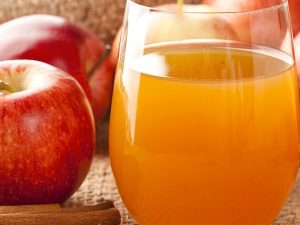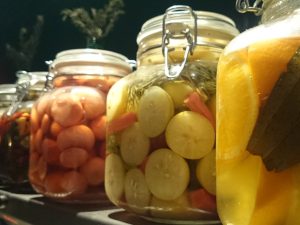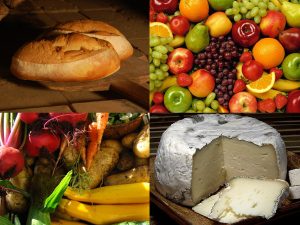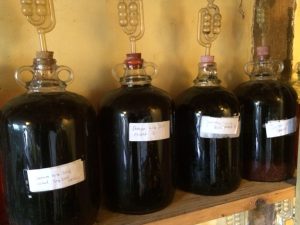Beer brewing - introduction

“Beer – it’s the best damn drink in the world” – Jack Nicholson
Contents
What is beer brewing?
It’s the making of all types of beer, a fermented, alcoholic drink. The main processes involved are:
- ‘Mashing’ – soaking a grain (usually malted barley) in hot water, which activates enzymes to break down the starch in the grain into simple sugars.
- Boiling of the ‘wort’ (water / sugar mix) with hops to add the desired flavour.
- Fermentation of the cooled liquid by adding brewer’s yeast (or allowing yeast in the air to do the job – ‘wild fermentation’ akin to sourdough breadmaking).
Different kinds of beer
The word is ‘styles’ – there are different beer styles, based on colour, taste, strength, ingredients, brewing techniques etc. The list of styles includes everything from bitter, mild and stout to lager, malt liquor and pale ale. The Beer Judge Certification Program (BJCP), a US-based non-profit, categorises beer styles and trains judges of beer competitions internationally. However, brewers can make whatever they like – there are no beer police that only allow certain types / categories – so you can invent your own beer.
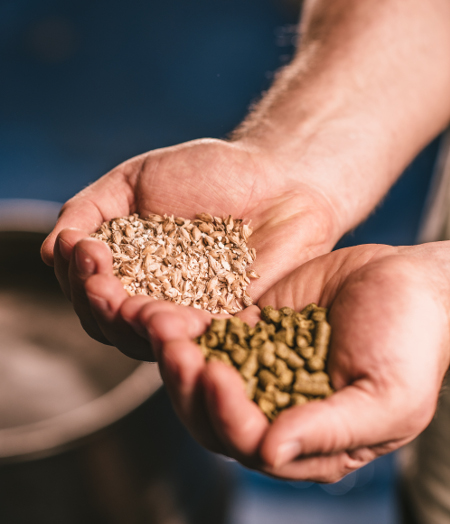
History
The oldest evidence of beer was in ancient Sumer, in modern Iraq / Iran over 7000 years ago. Remnants of beer and malted barley in bowls have been found, and the first recipe for beer is from the same area, around 4000 years ago. Beer seems to have had separate origins in China and Europe, thousands of years ago too, and eventually appears in any culture that grows grains.
Beer took off in Europe because of the ease with which barley grows, because beer is nutritious, and by the Middle Ages beer was often drunk rather than water, which could be contaminated. Hops started to be used by the 12th century. Before then, all sorts of plants had been used to tone down the sweetness of the malt, but hops became the most popular, as they added a pleasant bitterness that was thirst-quenching, and they’re also a natural preservative that prolongs the life of the beer.
By the Middle Ages, monasteries had taken over most beer production, and they came up with many new techniques, ingredients and recipes, many of which exist today. In the 20th century, beer production came to be dominated by large corporations, but since the 1970s, there has been a resurgence in craft / micro-breweries and homebrewing.
Wikipedia has a detailed history of beer and brewing.

What are the benefits of brewing beer?
- You’ll be reducing the distance that the beer has to travel to get to you, and if you re-use your bottles, you’ll extend their life and reduce the amount of energy required to make or recycle them.
- You can choose local, organic ingredients to reduce the environmental impact of your beer even further.
- However, after you’ve bought the necessary kit, and factored in time, electricity, ingredients, gas etc. (especially if you want to brew specialist beers with expensive ingredients), you won’t save much money, unless you use a kit, or unless you’re just looking to make alcohol without being bothered too much about quality or flavour.
- It’s a fun hobby – cost may not be your main concern – you can create really nice gifts for beer-lovers, and you could eventually turn your hobby into a business; local, independent breweries are good for communities in many ways.
What can I do?
There are more recipes online than you could ever try. Do some research, join some forums – there will be people out there keen to help you. Once you undersand the basics, get a brewing kit and ingredients from homebrewing supply shops anywhere, including online. You might find some basic kit around the house.
You need a water source, malt, hops, and brewer’s yeast. The biggest difference between styles is the malt. Stout is dark, so you need a darker malt. You can get special malts for any style of beer. So if you’re brewing pilsner lager, you can get pilsner malt etc. If you like a hoppy flavour, for any style of beer – just add more hops (unsurprisingly). For beginners, stick to the well-known styles first, before experimenting. You could even start with a kit.
You can make your own malt, but only if you’re really keen. The malting process is about sprouting barley in controlled temperatures and humidity. It’s very time-consuming and you have to be prepared to fail a few times – it’s doable but not economically viable on a small scale.
The size of vessels depends on the amount of beer you want to produce – but choose bigger equipment for heavier beers, because you’ll need more grain. The process will take the same amount of time (including set-up, cleaning etc.), and the beer will last, so you may as well make as big a batch as you can.
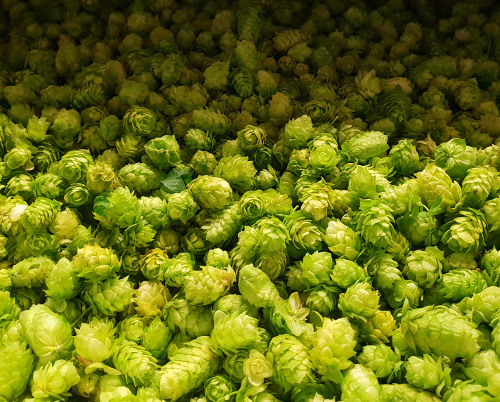
Wholegrain brewing process
The first step is mashing, and the vessel used is called a mash tun. Take malt – steep it in water at a certain temperature (usually around 65-73°C, depending on the type of beer and alcohol content you want), and for a certain time, depending on the recipe you’re using. This releases the starch from the malt and activates the enzymes, which break down the starch into simple sugars. After that has happened, you have to separate the spent grain from the wort (the water / sugar mix).
The next stage is boiling. Put your wort into a kettle or a copper, as it’s called (was traditionally copper, now mainly stainless steel). It’s a vessel that you can heat up using an external source of heat – including a gas hob. Add hops, depending on how bitter you want your beer, the types of aroma, flavour etc. If you don’t want a bitter taste, it’s possible to brew beer without hops at all. You can experiment to see what works for you.
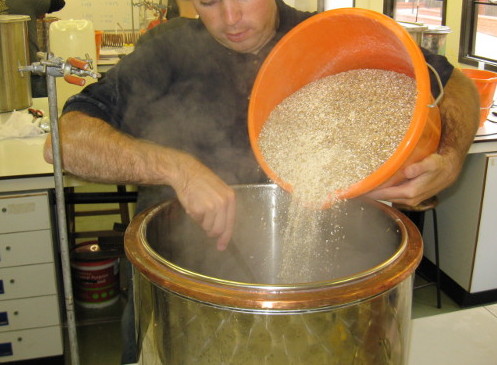
Boil for roughly an hour, depending on style. Next you have to add yeast, but you have to cool the wort down, because yeast is alive, and will be killed at boiling temperature. You can bring the temperature down with a simple heat exchanger – a coil of pipe in the boiler, through which you run cold water. Just leaving the vessel somewhere to cool down is an option, but there’s more chance of infection. If you have basic DIY skills, you should be able to make a very simple heat exchanger.
Transfer the cooled wort (c. 20°C) to a fermentation vessel. This could be a food-grade plastic bucket, but stainless steel will last longer. Add yeast, according to the recipe (you could try ‘wild fermenation’ with yeast from the air, but probably not as a beginner), and then leave it to do its job. After (usually) around 2-4 days, the fermentation is over.
Then if you leave the beer for 2-3 weeks, the taste will improve. All the various components of flavour and aroma need some time to merge together. Some beer styles will be ready quite quickly, and others will be better if you leave them for several months to get the right flavour / aroma profile – it depends on the style – just follow your recipe.
Homebrew kits
It’s the same process with a kit, but malt and hops are pre-mixed and need to be reconstituted with water before adding yeast. It’s much simpler, and so starting with a kit might be a good idea, to see if it’s for you. If you like it, you’ll want to switch to wholegrain brewing.
Bottling
You need to invest in a small bottling machine if you’re going to be making a reasonable amount of beer – or there’s something called Beergun, which is a bit more expensive, but works well (see video). You can fill bottles with a funnel, but it’s slow, and it may not be a good idea, as you want to avoid oxidation via the air. Hops are very fragile when it comes to oxygen, and if you oxidise your beer too much, it won’t taste good. So it’s best to do it in a way that minimised contact with air.
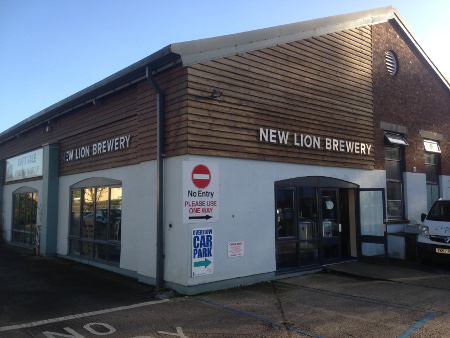
Brewing beer for a living
First contact a local micro-brewery (large brewers won’t have time for you). There are plenty around the country. Ask them if you can just come along and hang around, volunteer maybe, and just see what’s going on. You can see if the work is how you imagined it. You might envisage tasting beers, attending beer festivals and meeting people, but it also involves an awful lot of cleaning – so if you like cleaning, you’ll like brewing. It’s hard work, anti-social hours, sometimes stressful – it needs to be a labour of love.
If you want to start selling your own beer, you won’t make a living on a very small scale, although it can be a sideline. There are several hoops you have to jump through. The Society of Independent Brewers (SIBA) provide information on setting up an independent brewery.
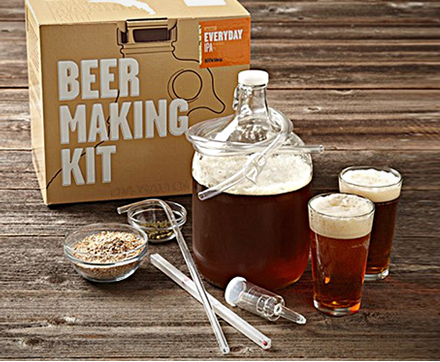
Buying beer
All towns deserve local, independent brewers that produce real ales and keep profits within their community. CAMRA (Campaign for Real Ale) have a directory of pubs serving real ales.
Be careful – small breweries are often bought out by giant American or Japanese corporations, but the name stays the same and it’s difficult to tell. For example, Fuller’s is no longer a family brewer since being bought by Japanese giant Asahi, who also took over Greenwich-based ‘Meantime’ brewery via AB InBev, the world’s largest brewing corporation. Operations remain the same (Meantime’s website tries to portray Meantime as a small business) – all that has changed is that profits are transferred from the community to international investors.
Here’s an idea: it’s hard to know whether beers in shops and pubs are by independent brewers, so research and find a genuinely independent brewer and order a crate delivery once a month.
Specialist(s)
Thanks to Jac Ziegler, head brewer at the community-owned New Lion Brewery for information.

